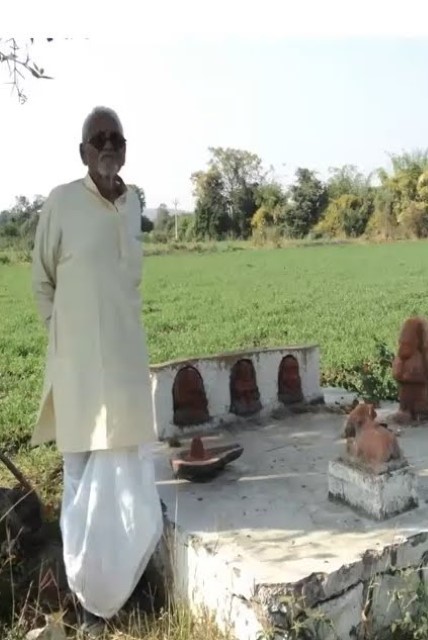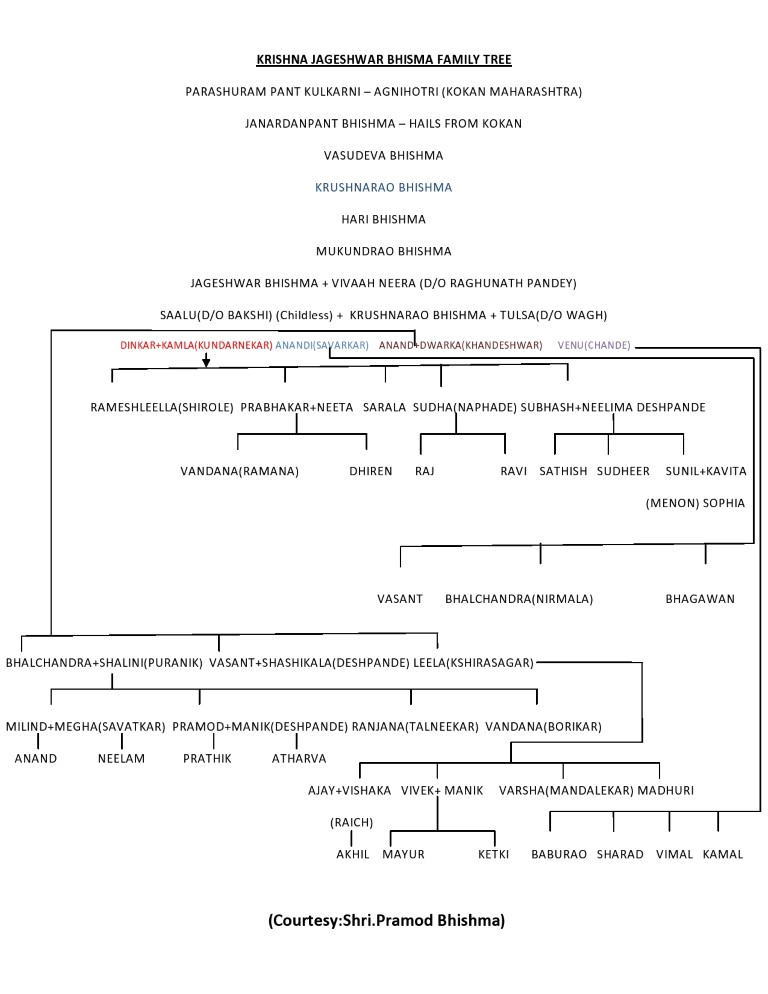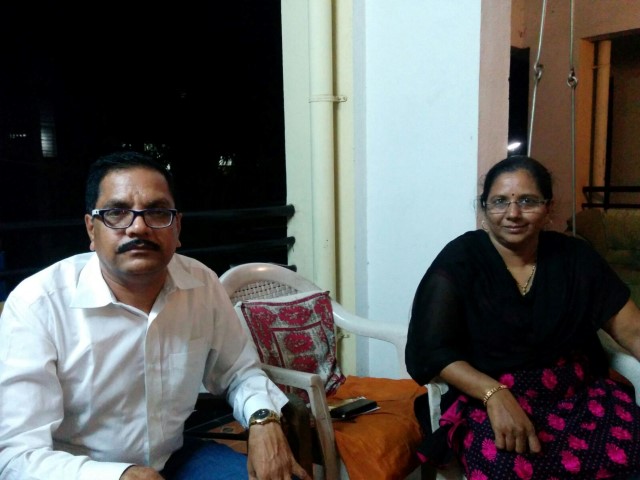|
A Sanskrit scripture proclaim “Shateshu Jaayate Shooraha, Sahasreshucha Panditaha” meaning “Among hundred people who take birth, only one will be born as a Warrior and Among thousand people who take birth, only one will be born as a Pandit (Learned Person)”. Shri.Swami Krishnanand (Krishnarao Jageshwar Bhishma) was born like that one in thousands of Pandits. Parama Poojya Shri.Bhishma was a great personality but very few people know about the greatness of Shri.Bhishmaji. He was not only a Revolutionary but was also a Spiritual Person of highest order. He dedicated his entire life for the purpose of doing Social Service. We are giving below details of Shri.Bhishma who was an Excellent Revolutionary as well as Spiritual Personality. Shri.Krishnarao Bhishma was born on 16th August 1854 in a place known as Bootibori (now an Industrial suburb) near Nagpur. He was born in a rich family that owned vast 10 acres of Agriculture land. By the grace of God, Bhishma got a very good job of Revenue Inspector and started working at an early age. But, his mind all the time was completely occupied with patriotism. Around the year 1904-1906, one Dr.Khanakhoje and Shri.Ramlal Vajapayi started a secret Underground Organization at Nagpur. Group of Youths started joining this organization. Shri.Gopalrao Tongo, Shri.Bavuji Kavre, Shri.Appa G. Halde, Shri.Bhavani Shankar Niyogi, Shri.Govind Rao Deshmukh and Shri.Krishnarao Bhishma also joined this organization. The secret meetings of this group were held in the cellar of Smt.Saloo Bai Mohite’s old house. Saloo Bai was a princess who extended financial support to the revolutionaries. The ultimate aim of everyone was to make India free from the clutches of Britisher’s Rule. In addition to being associated with the above outfit, Shri.Krishnarao Bhishma was also associated with Dr.Munje and Dr.Hedgewar. One day Dr.Munje was performing pooja in his house. Shri.Bhishma was also present in his house. Dr.Munje had a book written by great freedom fighter Shri.Vir Savarkar titled “1857 che Swatantra Samar” in his possession. The British Government had banned this book. On receiving information from secret informers, the Police raided the house of Dr.Munje and sealed his house. Shri.Bhishma was successful in hiding the book in a Dustbin. Hence, the Police personnel were not able to trace the book. But, the police forced Dr.Munje and Shri.Bhishma to beg pardon from them. In this way, the struggle for freedom was going on secretly in the country. During this period, Bhisma’s wife passed away. At that Bhishma had 4 Children i.e., 2 Sons and 2 Daughters. Due to untimely death of his Wife, Bhishma’s mind started turning towards seclusion. Hence, Bhishma kept himself busy in Kirtans, Bhajans, Pooja and in inclucating Patriotism among the people of the Country. During this time, he composed several poems of historical importance based on Yatartha Ramayana, Shri Bhagavad Gita, 7 Chapters of Shri Satyanarayana Katha, the life during the days of Ramayana, The Geographical Position and State of Affairs during the period of Ramayan, Chatrapati Shivaji Maharaj etc..Through these historical poems and discourses, he was successful in creating patriotism and for achieving freedom from Britishers in the minds of people of our country. One more specialty about Shri.Bhishma was that he was also an efficient Doctor who treated people during his free time. In this way, Shri.Bhishma relentlessly continued his Social Service activities. Once, programme of “Asprushyata Nivaran Parishad” (Untouchability Eradication Organization) was going on in Mohpa village in full swing. In this programme, Shri.Bhishma spoken gave a powerful speech on the subject of Having Food with an Untouchable person. This politically thunderous speech made all the people to start looking at Shri.Bishma as a National Leader. In the month of Shravan in 1908, on the night of Purnima he had a dream. He saw a person of dark complexion with tripundra mark on his forehead, sandal-wood paste mixed with saffron applied to his body and Puja offered at his feet. He gave Bhishma a newspaper. Bhishma enquired of him as to who he was. He did not reply but pointed to the newspaper on which “Sat-Chit-Anand” was printed in bold letters. He directed Bhishma to read. Bhishma looked at the newspaper wherein he saw the words “Mantra va shikava” which means “chant mantra and learn”. Bhishma was intrigued and wanted to question the dark person, but both the person and the newspaper had vanished. Bhishma was mystified, but in the meantime he heard a knock at the door and he emerged out of his dream. He lost no time in recording this dream. Thereafter he thought long about his dream but was unable to unravel the mystery. After a few days a sadhu, a devotee of Ganesh, visited Bori. Bhishma narrated his dream to the sadhu who told him that “Sat-Chit-Anand Swami” was his guru, and gave him the mantra “Va Shikava”. After sometime Bhishma happened to visit Amraoti where Dadasaheb Khaparde asked him whether he would like to accompany him to Shirdi. He agreed and in the company of Khaparde arrived in Shirdi. There is a mention of Bhishma in Khaparde’s Diary pertaining to his second and long stay at Shirdi beginning from 6th December 1911. As soon as Bhishma went to the Musjid for Sai Baba’s darshan, Sai Baba with folded hands exclaimed “Jaya Sat-Chit-Anand”. Bhishma was perplexed. He wondered whether the sadhu of his dream was Sai Baba. However, the sadhu of his dream was a Vaishnavite while Sai Baba appeared to be a Muslim! Yet, why Sai Baba uttered Sat-Chit-Anand? All Brahmin devotees of Sai Baba took tirtha but Bhishma did not. Sai Baba used to smoke the chillim and often invited others to have a puff but excluded Bhishma in the beginning. Once while Sai Baba was narrating a story, a devotee got the chillim ready and gave it to Sai Baba. Sai Baba held it out to Bhishma and directed him to smoke after merely touching the chillim to his mouth. Bhishma had a puff and returned it to Sai Baba. Sai Baba accepted it and remarked, “I roam everywhere, my friend – Bombay,Pune, Satara, Nagpur; all those towns are filled with the presence of Rama”. Then he suddenly said to Bhishma, “You eat laddus alone by yourself without offering anything to me. At least now give me five laddus”. It is well known that Sai Baba asked for dakshina from every devotee and spent the amount collected for charitable purposes. Sai Baba’s remark had a strange effect on Bhishma. The distinction between the Vaishnav sadhu of his dream and Sai Baba disappeared. He knowingly asked the sevak for Sai Baba’s tirtha and placed his head on Sai Baba’s feet. Sai Baba put his palm on Bhishma’s head for two full minutes. Bhishma went into ecstasy. How could he describe the state of his mind except by saying like Devnath in his famous composition “Gurukrupayka uhnjuna paya mera main janu”. “The Guru’s Grace I have received I know it for myself”. Bhishma returned to his lodging, brooding on how he could prepare five laddus in a place where he himself was a guest. Even otherwise he would have had to take the assistance of another person for the purpose and Sai Baba would have surely known about it. Moreover, why did Sai Baba ask him for only five laddus and not laddus generally? He spent a day thinking about the deeper meaning thereof and fell asleep with this thought uppermost in his mind. Suddenly he woke up and was inspired to compose a stanza. In the morning while he busied himself with the second stanza, Hari Sitaram Dikshit, on his way to the Masjid, saw the stanza. After his bath, Bhishma went to the Masjid. Sai Baba reminded him about the laddus. Bhishma kept quiet but Dikshit replied that laddus were being prepared. On hearing this Sai Baba fell into a silence. Next day, Bhishma completed five stanzas, and however hard he tried, he could not compose any more. So he placed the composition of five stanzas into Sai Baba’s hands.Sai Baba asked him to recite them. While he was reciting, Sai Baba again blessed him by putting his palm on his head and Bhishma felt exalted. Thereafter Bhishma would compose a verse and show it to Sai Baba who would order him to render it. Thus the booklet “Shri Sainath Sagunopasna” wrote itself and was offered at Sai Baba’s feet. Dadasaheb Khaparde has the booklet published at his expense till 1922. Later on in 1923, after Shri Sai Baba Sansthan was founded, with Bhishma’s consent a revised edition was planned and published by the Sansthan with incorporation of more compositions therein. Bhishma prepared a booklet entitled Shri Sainath Sagunopasana which contained,besides the Arati, psalms sung in Arati to Shri Sai Baba, some traditional hymns from the Hindu liturgy like, Purusha Suktam, Sree Suktam, Mantra Pushpam, Sri Lakshmi Ashtotharam, intended for use in the daily worship of the devotees. Shri G.S. Khaparde had borne all the expenses of its publication till 1922, After Baba's Mahasamadhi, the book has been adapted as the official 'Book of Daily Worship' at the Samadhi Mandir.Shri Sai Baba Sansthan, Shirdi, on making some additions to it, has taken up the publication of the revised edition since 1923. In all, there are thirty psalms in the Book of Shirdi Aratis. Of the thirty, only sixteen are especially composed on Shri Sai Baba. The rest (fourteen, i.e. about half), are traditional Arati psalms composed by the mediaeval poet-saints of Maharashtra (excepting a Vedic chant). Of the fourteen traditional psalms, five are composed by Sant Tukaram Maharaj, two each by Sant Namadev and Sant Janabai, one each by Shri. Ramjanardhan Swami and Shri. Rameshwar Bhat; of the remaining three, one is a Vedic hymn and the other two are traditional prayers. Of the sixteen, psalms especially written on Shri Sai Baba, the major bulk, i.e. nine, are composed by Shri. K.J. Bhishma, three by Shri. Dasganu Maharaj, one each by Shri.Upasani Maharaj, Shri. Madhav Adkar, Shri. Mohini Raj and Shri. B.V. Dev. Linguistically, of the thirty Arati psalms, twenty five are in Marathi, two in Hindi, two in Sanskrit and one a bilingual anthology of short Marathi and Sanskrit prayers. During those days, Urus festival was being organized every time during Ramanavami and Krishna Janmashtami. Bhishma mooted just before the Urus festival, the idea of celebrating Ramnavami and Krishna Janmashtami festival. Accordingly, Shri.Bhishma consulted Kaka Saheb Dixit regarding the matter who advised Bhishma to speak directly with Baba. Sai Baba displayed an extremely hot temperment and hence no one dared to speak directly with Him. In the end, Bhishma directly approached Baba and spoke to Him about the festival and Baba readily gave permission to conduct it. Baba asked Bhisma as to who will perform the Pooja, Bhajan and Kirtan during the festival. The residents of Shirdi started working overnight and made all the necessary arrangements and thus Urus festival and Ramnavami festival were combined in 1912 and the celebration of both the festivals was performed with great zeal and on a grand scale.Shri Sai Baba Sansthan has continued this tradition and the festival is being conducted in grand manner even today. One more incident that happened is as follows: Shri.Bhishma once had gone to Umred to give a discourse. While returning back to Mohpa he had to cross a river which was flooded due to heavy rain. The Bullock which was pulling the Bullockcart refused to enter the river. Shri.Bhisma immediately closed his eyes, prayed Baba and requested Him to bail him out of the situation. At once the Bullock jumped to the river and started putting giant strides. The onlookers were wonderstruck at the turn of events. Bhishma opened his eyes and could see Sai Baba standing in front of him. Bhishma at once got out of the Bullock Cart and prostrated to Him. As the onlookers were not able to see anyone, they were wondering to whom Bhishma was prostrating. Bhishma went on a pilgrimage all over India. In the year 1930, he went on a pilgrimage from Rameshwar to Kashi and again from Kashi to Rameshwar. Finally when he returned back to Mohpa in the year 1933, people accepted him to be a Siddapurush. He continued to do Social Service relentlessly. From 1934, his health started deteriorating. On the auspicious day of Nag Panchami in the year 1935 his health condition became worse. But, he survived only because of the the excellent will power that he had. During that time, he was conducting research on Ramayan. The most amazing fact is that after Baba took Samadhi in the year 1918, Bhishma stopped taking food every day and took food only once in a year i.e., Dwadashi Day of Margashira Masa which happened to be the festival of Sachidananda Swamy. On all the other days of the year, he used to survive only by taking Fruits, Milk etc. This austerity he continued for 17 long years. During the last one year before he took Samadhi, Bhishma survived by consuming Milk only. Thus, Bhishma lived the life of a great Yogi. One day when his Daughter in law asked him whether he has been called by Lord Ram, Bhishma had already knew about his death. Bhishma replied her "my time to depart from this world has come. Kindly give the holy water of Sachidananda Swami". His daughter in law promptly made him drink the holy water of Sachidananda Swami. He uttered "Ram-Ram", took the holy water and breathed his last on Saturday, 8th August 1935. A bright light went out from his body and merged in the five elements. Since Bhishma lived the life of a Saint, during his funeral procession, his body was taken in a sitting position and laid to rest. The Samadhi of Shri.Krishnashastri Jageshwar Bhishma has been made at Mohpa Village, Kalmeshwar Taluk, Nagpur District of Maharashtra. Mohpa is situated at a distance of about 35 KM on the Nagpur to Kalmeshwar Road. From Mohpa Bus Station, travel towards Ganeshpet and from there a little further away is Mor Bhavan, Nagpur.
Krishna Shastri Jageshwar Bhishma's Samadhi Sthal Family Tree of Shri.Krishna Shastri Jageshwar Bhishma:
His Great Grand Son Shri.Pramod Bhishma is continuing the legacy of his Great Grand Father. Shri.Pramod Bhishma and Smt.Manik Ji We have given below the contact details of Shri.Pramod Bhishma, Great Grandson of Shri.Krishna Shastri Jageshwar Bhishma for the benefit of Sai Devotees: Shri.Pramod Bhishma (Source: Shri Sai Leela, September 1985 Issue, Personal Interview Smt.Shreya Nagaraj had with Shri.Pramod Bhishma, Great Grand Son of Shri.Krishnashastri Jageshwar Bhishma on 1st September 2015, Photo Courtesy: Smt.Shreya Nagaraj, Bangalore Shri.Jignesh C.Rajput, Surat) |



